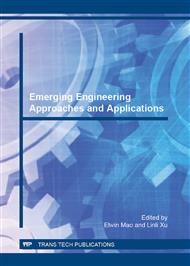[1]
Zhao YY, Qin B, Liu T, A Survey of Sentiment Analysis, Journal of Software, Vol. 21, No. 8, 1834-1848, (2010).
Google Scholar
[2]
Huang XJ, Zhao J. Sentiment Analysis for Chinese Text. Communications of CCF, 4(2), (2008).
Google Scholar
[3]
Rao D, Ravichandran D. Semi-supervised Polarity Lexicon Induction. In: Proceedings of EACL-2009, pp.675-682, (2009).
DOI: 10.3115/1609067.1609142
Google Scholar
[4]
Wiebe J. Learning Subjective Adjectives from Corpora. In: Proceedings of AAAI. (2000).
Google Scholar
[5]
Kim SM, Hovy E. Automatic Detection of Opinion Bearing Words and Sentences. In: Proceedings of IJCNLP-2005, pp.61-66, (2005).
Google Scholar
[6]
Yao TF, Peng SW. A Study of the Classification approach for Chinese Subjective and Objective Texts. In: Proceedings of the NCIRCS-2007, pp.117-123, 2007. (in Chinese with English abstract).
Google Scholar
[7]
Pang B, Lee L. A Sentimental Education: Sentiment Analysis Using Subjectivity Summarization Based on Minimum Cuts. In: Proceedings of ACL-2004, pp.271-278, (2004).
DOI: 10.3115/1218955.1218990
Google Scholar
[8]
Hu MQ, Liu B. Mining and Summarizing Customer Reviews. In: Proceedings of KDD-2004, pp.168-177, (2004).
Google Scholar
[9]
Turney P. Thumbs up Or Thumbs Down? Semantic Orientation Applied to Unsupervised Classification of Reviews. In: Proceedings of ACL-2002, pp.417-424, (2002).
DOI: 10.3115/1073083.1073153
Google Scholar
[10]
Pang B , Lee L, Vaithyanathan S. Thumbs Up? Sentiment Classification Using Machine Learning Techniques. In: Proceedings of EMNLP-2002, pp.79-86, (2002).
DOI: 10.3115/1118693.1118704
Google Scholar
[11]
Information on http: /ir. dcs. gla. ac. uk/wiki/TREC-BLOG.
Google Scholar
[12]
Information on http: /research. nii. ac. jp/ntcir.
Google Scholar
[13]
Zhao J, Xu HB, Huang XJ. Overview of Chinese Opinion Analysis Evaluation 2008. COAE2008, 1-20, (2008).
Google Scholar


